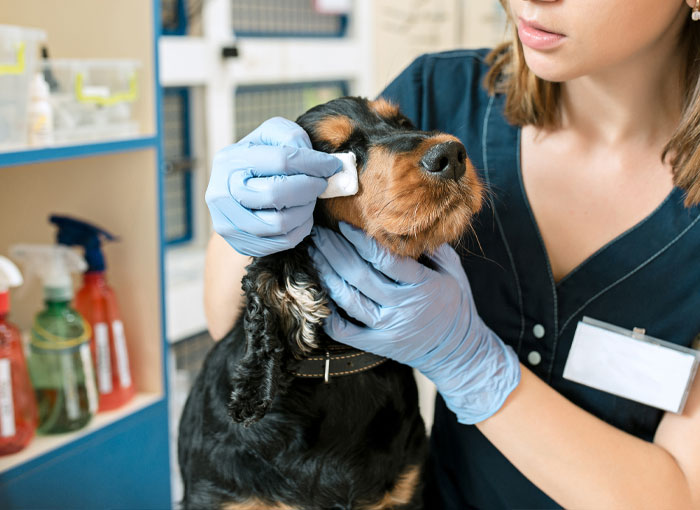Have you seen those reddish-brown marks under your dog’s eyes and wondered about them? These marks are not just a cosmetic issue – they’re a window into your dog’s health and well-being. Dogs, especially those with lighter fur, can get these stains, which don’t harm them but can change how they look. And sometimes, these marks can point to health issues. While often associated with certain dog breeds like Maltese or Shih Tzus, any dog can have these stains. Different things can cause them, like:
HighlightsTear stains in dogs can signal health issues beyond cosmetic concerns.Certain breeds are more prone to tear stains due to facial structure.Blocked tear ducts, allergies, and diet can all contribute to tear staining.Regular grooming, high-quality diet, and clean water can prevent tear stains.Probiotics may be safer and more effective than antibiotics for treatment.
But don’t worry, there are good ways to treat and stop these stains, ensuring your furry companion stays happy & healthy.
This guide will help you understand:
So let’s learn how to help your furry friend stay healthy and free from tear stains!
The information provided herein is for informational purposes only. Please refer to ourdisclaimerfor more details..
Table of ContentsUnderstanding Tear Staining in DogsWhat Causes Tear Stains On DogsTear Stains Diagnosis in DogsTear Staining Treatment in DogsHow to Remove Dog Tear Stains At HomeTips to Prevent Tear StainingFinal Thoughts
Understanding Tear Staining in Dogs
Image credits:wildopossum

Tear stains are those reddish-brown marks you often see near a dog’s eyes. They’re a usual worry for pet owners. These stains show up more on dogs with light fur, like Bichon Frises orMaltese. The main reason for these stains isepiphora– which is when tears spill over because they’re not draining right.
Normally,tears should drain into the nasolacrimal duct, but if this duct is blocked or underdeveloped, tears end up outside the eyes. And this leaves a colored mark. This color comes fromporphyrins, iron-containing moleculesproduced when the body breaks down red blood cells. Porphyrins are naturally excreted in tears, saliva & urine. However, they’re more visible in dogs with light fur.
Some breeds get tear stains more,especially those with short noses, flat faces, and big eyes or shallow eye sockets, like:
In these breeds, the way their eye sockets and tear ducts are made doesn’t help tears drain well, so they spill over.Usually, this isn’t harmful. But it’s important for pet owners to know that too many tears can sometimes mean health problems or lead to infections if not cleaned. So regular cleaning & seeing a veterinarian if you’re worried is the best way to keep your dog comfortable and healthy.
What Causes Tear Stains On Dogs
Tear stains on dogs have multifaceted causes. Contrary to popular belief, they’re often not due to excessive tear production, but rather a combination of physical and environmental factors.
Allergies can make the area around their eyes swell – which blocks tear ducts. And, being around irritants like smoke or some shampoos can also cause more tears & stains.
Knowing these causes is important for dog owners. While you can’t change genetics, you can manage allergies, keep good hygiene, and get vet help for health problems. This can help reduce the severity of tear stains in dogs.
Tear Stains Diagnosis in Dogs
If your dog has lots of tear stains, it’s important to see a vet. The vet will do a full eye exam. The process involves:
Finding the exact cause is important. As it helps decide the right treatment or surgery to fix the tear stain problem effectively.
Tear Staining Treatment in Dogs
Image credits:master1305

But, if tear stains are due to thedog’s facial shape, like normal tears spilling over – it’s harder to treat. One way is with low-dose antibiotics, but this isn’t really safe & not recommended. Because it can lead to the potential development of antibiotic-resistant bacteria.
A better choice isprobiotics. They can help reduce or even get rid of tear stains without the bad side effects of antibiotics. This is a safer way to handle tear stains. So always talk to your vet to find the best treatment for your dog’s tear stains.
How to Remove Dog Tear Stains At Home
Before you begin, it’s crucial to ensure no underlying medical conditions are causing the stains with your veterinarian’s help. And once health issues are excluded, you can try various over-the-counter options and home remedies. Be careful when cleaning your dog’s face – as you might need to try a few ways to see what works best.
Note:Be careful with products containing Tylosin – an antibiotic. This is controversial and not recommended due to unpredictable results. It can be risky and might lead to drug resistance. Always choose safe options and talk to your vet before trying new treatments for tear stains on your dog.
Tips to Prevent Tear Staining
Image credits:Alpha1Actual

To stop tear stains in dogs, especially in breeds that get them a lot, you need to groom them regularly & watch their diet and environment. Here are some good ways to keep tear stains away:
And remember, results may vary, and it’s important to find what works best for your dog.
Every dog is different, so you might need to try a few of these methods to see what works. Being consistent and patient is important to stop tear stains in dogs.
Final Thoughts
Understanding and taking care of tear stains in dogs is a big part of being a good pet owner. As we’ve seen, these stains can mean more than just a change in looks. They can point to health issues. So being aware and active in caring for your dog can keep them comfortable & healthy. And remember, things like regular grooming, good food & changing their environment are key in stopping & treating tear stains. As every dog is unique. And finding what works best for you may take some time and patience. So, take on the responsibility of caring for your dog – knowing that what you do really helps your furry friend.
378views378views
Pet Wellness